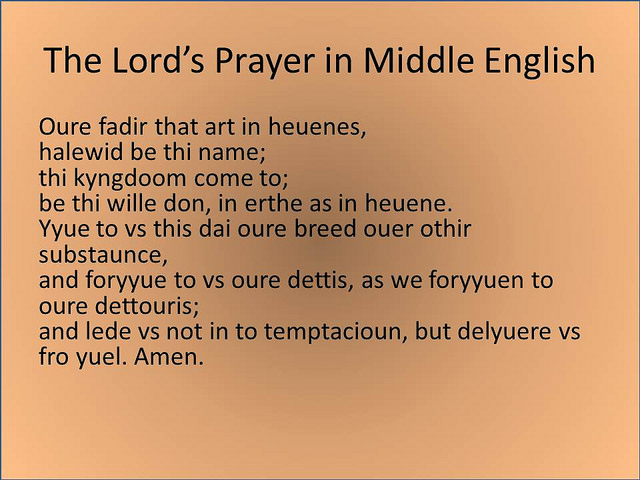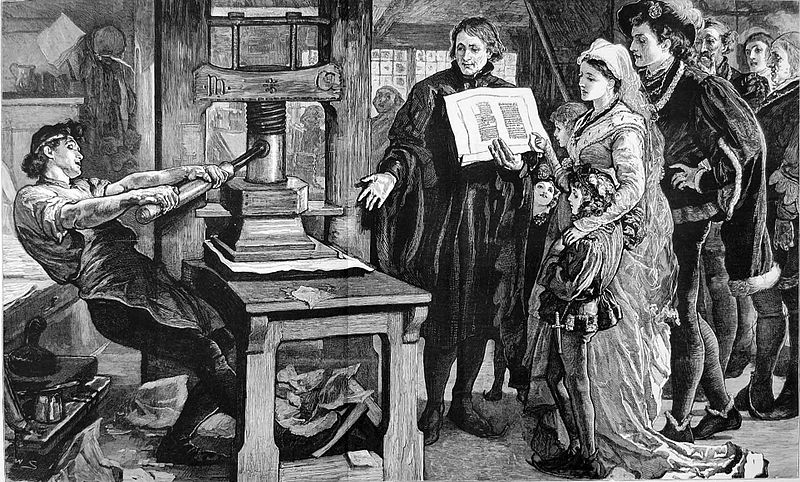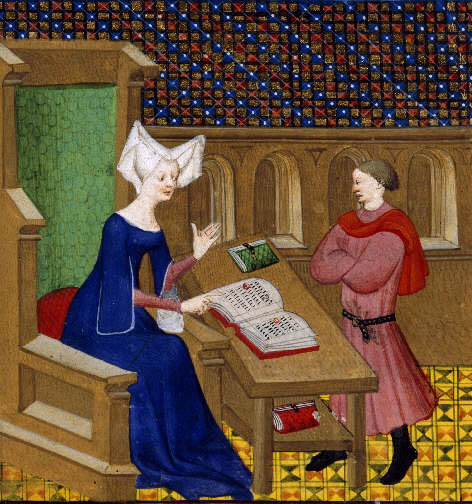 Middle English (c. 1100 – 1500)
Middle English (c. 1100 – 1500)
The change from Old English to Middle English took place in the years following the Norman Conquest.
This was a slow change which gradually saw the multiple different endings of Old English words replaced by more grammatical words of Middle English.
The ‘s’ ending began to be used almost exclusively to pluralise nouns and many other changes happened within English as it evolved rapidly as a spoken language.
Spelling and Pronunciation
The period of English that we call Middle English began directly after the Norman Conquest in 1066 and continued until the English Renaissance period, which began around 1500.
Because English has been relegated to a third language in its own country during the reign of the Normans, English was a spoken rather than a written language at this time.
This meant that the connection between spelling and pronunciation was very precarious.
In fact, despite the wealth of vocabulary and many borrowed words, the spelling of words was rather random in Middle English, with writers using many different spellings for the same words.

The Return of English
The reason why there are many words in the English language that are pronounced very differently from how they are written is due to the changes that occur in spoken language over time.
Although pronunciation can change relatively rapidly, these changes in speech are not reflected in spelling so quickly.
This is the reason why so many words in English seem to be spelled illogically – the spellings made sense once!
It is estimated that up to 85% of Anglo-Saxon words were lost from English during the Viking invasions and the Norman Conquest.
However, after The Hundred Years’ War against France (1337 – 1453), English had a surge in popularity again due to French being now deemed ‘the language of the enemy’.
In 1348, English replaced Latin as the medium of instruction in schools.
Literature of Middle English
In the 13th century, literature began to be written in Middle English, rather than French or Latin.
In the 1380s, Geoffrey Chaucer began writing The Canterbury Tales, throughout which he introduces around 2,000 new words into the English language.
In addition to using borrowed words from French, Chaucer also used words from Old English and re-introduced forgotten words. This exciting and inclusive approach gave the English language a whole new lease of life.
The Language of Chaucer
Some of the words Chaucer re-introduced from Old English include: ‘friendly’, ‘loving’, ‘restless’ and ‘churlish’.
He also introduced many diverse new words into Middle English that we still use today, including: ‘outrageous’, ‘village’, ‘rumour’, ‘desperate’, ‘laxative’, ‘horizon’, ‘infect’, ‘Valentine‘, ‘superstitious’ and ‘snort’.
Despite all these new words, the spelling of Middle English was still very random. Chaucer himself spelled his own words differently throughout his own manuscripts. For example, the word ‘year’ can be found written as ‘yeer’ and ‘yere’, while the word ‘sight’ can be found written as ‘site’, ‘sighte’ and ‘cite’ in different texts.
The Standardisation of English
This lack of regularity in spelling was a great hindrance to people trying to read and write English.
No one knew how to spell a word and as everyone chose different spellings in Middle English. This proved troublesome for record-keeping as well as for creative and formal writing. But standardisation was not far away.
One of the great inventions that helped the push towards the standardisation of spelling in English was the printing press.
The Printing Press
The printing press was brought to England by William Claxton in 1476.
This new machine made books much cheaper to produce and to buy and therefore levels of literacy climbed much higher among the English people. This also helped begin the greater standardisation of spelling and grammar.

By the 15th century, the English language had changed considerably, partly due to the introduction of the printing press, which had stabilised spelling and grammar.
Because more were books being produced, there was a need to write words in the same way, so a standard spelling had to be agreed upon.
Readers of this time, after the development of the printing press, would have found Old English to be almost incomprehensible, just as most modern readers find Chaucer’s language impossible to understand today.
The printing press helped standardise spellings to some extent, but it was not until the first dictionaries were published in the Early Modern period that standardisation would be improved still further and the English language would move into a new era.
Share your thoughts on Middle English
Have you ever read any Middle English?
Do you like standardised spellings or would you prefer the freedom to choose your own spellings?
Next: Early Modern English
Attributions
- Christine de Pisan instructs her son, Jean de Castel. Collected Works of Christine de Pisan, circa 1413. Attributed to Bedford Master. [Public domain], via Wikimedia Commons
- The Lord’s Prayer in Middle English by attanatta via Flickr [CC BY 2.0]
- William Caxton showing specimens of his printing to King Edward IV and the Queen. Published in The Graphic in 1877 referring to The Caxton Celebration, which commemorated the 400th anniversary of the first printed book in England and took place in London in the summer of 1877. [Public domain or Public domain], via Wikimedia Commons

